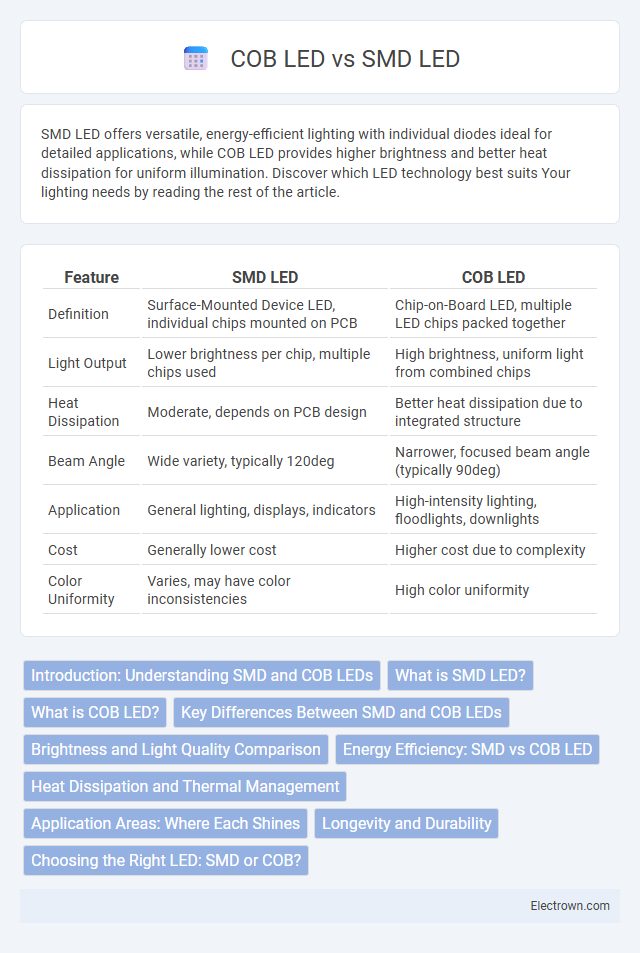SMD LED offers versatile, energy-efficient lighting with individual diodes ideal for detailed applications, while COB LED provides higher brightness and better heat dissipation for uniform illumination. Discover which LED technology best suits Your lighting needs by reading the rest of the article.
Table of Comparison
| Feature | SMD LED | COB LED |
|---|---|---|
| Definition | Surface-Mounted Device LED, individual chips mounted on PCB | Chip-on-Board LED, multiple LED chips packed together |
| Light Output | Lower brightness per chip, multiple chips used | High brightness, uniform light from combined chips |
| Heat Dissipation | Moderate, depends on PCB design | Better heat dissipation due to integrated structure |
| Beam Angle | Wide variety, typically 120deg | Narrower, focused beam angle (typically 90deg) |
| Application | General lighting, displays, indicators | High-intensity lighting, floodlights, downlights |
| Cost | Generally lower cost | Higher cost due to complexity |
| Color Uniformity | Varies, may have color inconsistencies | High color uniformity |
Introduction: Understanding SMD and COB LEDs
SMD (Surface-Mounted Device) LEDs feature individual diodes mounted on a flat surface, offering high brightness and versatility for various lighting applications. COB (Chip on Board) LEDs consist of multiple LED chips packaged closely together as a single module, providing superior light uniformity and efficiency. Comparing SMD and COB LEDs involves evaluating factors such as lumen output, heat dissipation, and installation flexibility for optimized lighting solutions.
What is SMD LED?
SMD LED (Surface-Mounted Device Light Emitting Diode) is a type of LED where the light source is mounted directly onto the surface of a circuit board, allowing for a compact and efficient design. These LEDs offer high brightness levels, diverse color options, and excellent heat dissipation, making them ideal for various lighting applications such as displays, signage, and residential lighting. Your choice of SMD LED ensures energy-efficient performance with versatile design flexibility in modern lighting solutions.
What is COB LED?
COB LED (Chip on Board Light Emitting Diode) features multiple LED chips packaged directly on a single substrate, creating a unified light source with higher lumen density and superior thermal performance compared to SMD LEDs. This design enhances brightness and uniformity, making COB LEDs ideal for applications requiring intense, focused illumination such as spotlights and high-bay lighting. COB LEDs also offer improved energy efficiency and reduced light scattering, resulting in better optical efficiency and longer lifespan.
Key Differences Between SMD and COB LEDs
SMD LEDs are surface-mounted components featuring multiple individual diodes on a single chip, allowing for versatile applications and compact design with multicolor options, while COB LEDs consist of a large single chip with multiple diodes integrated closely, providing higher lumen output and better heat dissipation. The key differences between SMD and COB LEDs lie in light uniformity, power efficiency, and thermal management, with COB LEDs delivering smoother light with fewer hotspots and improved energy efficiency compared to SMDs. Your choice depends on the intended use, balancing the need for customizable light configurations with the demand for high-intensity, uniform illumination.
Brightness and Light Quality Comparison
COB LEDs deliver higher brightness with a more focused and uniform light output due to their design, making them ideal for applications requiring intense illumination. SMD LEDs provide versatile light quality with better color temperature options and wider beam angles, enhancing your lighting customization. Comparing both, COB LEDs excel in brightness, while SMD LEDs offer superior control over light quality and distribution.
Energy Efficiency: SMD vs COB LED
SMD LEDs exhibit higher energy efficiency with a luminous efficacy typically ranging from 80 to 120 lumens per watt, due to their individual diode design allowing better heat dissipation and lower power consumption. COB LEDs, while providing superior light uniformity and higher brightness density, generally have slightly lower energy efficiency, averaging around 70 to 100 lumens per watt, because multiple diodes are packed closely, generating more heat. Choosing between SMD and COB LEDs for energy efficiency depends on specific application needs, balancing brightness output, heat management, and power consumption.
Heat Dissipation and Thermal Management
SMD LED modules offer better heat dissipation due to their smaller size and ability to be mounted on larger heat sinks, improving thermal management in compact applications. COB LEDs generate more heat concentrated in a single chip area, requiring advanced cooling solutions to maintain optimal performance and longevity. Your choice between SMD and COB LEDs should consider how effectively each design handles heat to ensure reliability and efficiency in your lighting system.
Application Areas: Where Each Shines
SMD LEDs excel in applications requiring versatile lighting solutions, such as residential, commercial, and automotive lighting, due to their compact size and ability to produce multiple colors. COB LEDs are ideal for high-intensity lighting needs like street lamps, floodlights, and industrial lighting because of their superior heat dissipation and uniform light output. Your choice between SMD and COB LEDs should depend on the specific application area's brightness requirements and spatial constraints.
Longevity and Durability
SMD LED technology typically offers a longer lifespan due to its individual diode design, which allows for better heat dissipation and reduced risk of failure over time. COB LED modules, while providing intense brightness, may experience shorter longevity because the dense arrangement of diodes generates more concentrated heat that can accelerate wear. Choosing the right LED type for your application involves considering how durability and heat management impact the lifespan of your lighting solution.
Choosing the Right LED: SMD or COB?
Selecting between SMD LED and COB LED depends on application-specific needs such as brightness, energy efficiency, and beam angle. SMD LEDs offer versatile light distribution with individual diodes, making them ideal for decorative and detailed lighting, while COB LEDs provide a uniform, intense light output suitable for high-intensity tasks and large areas. Prioritize SMD LEDs for flexibility and multi-color options, whereas COB LEDs excel in delivering focused, high-lumen illumination with excellent thermal performance.
SMD LED vs COB LED Infographic

 electrown.com
electrown.com